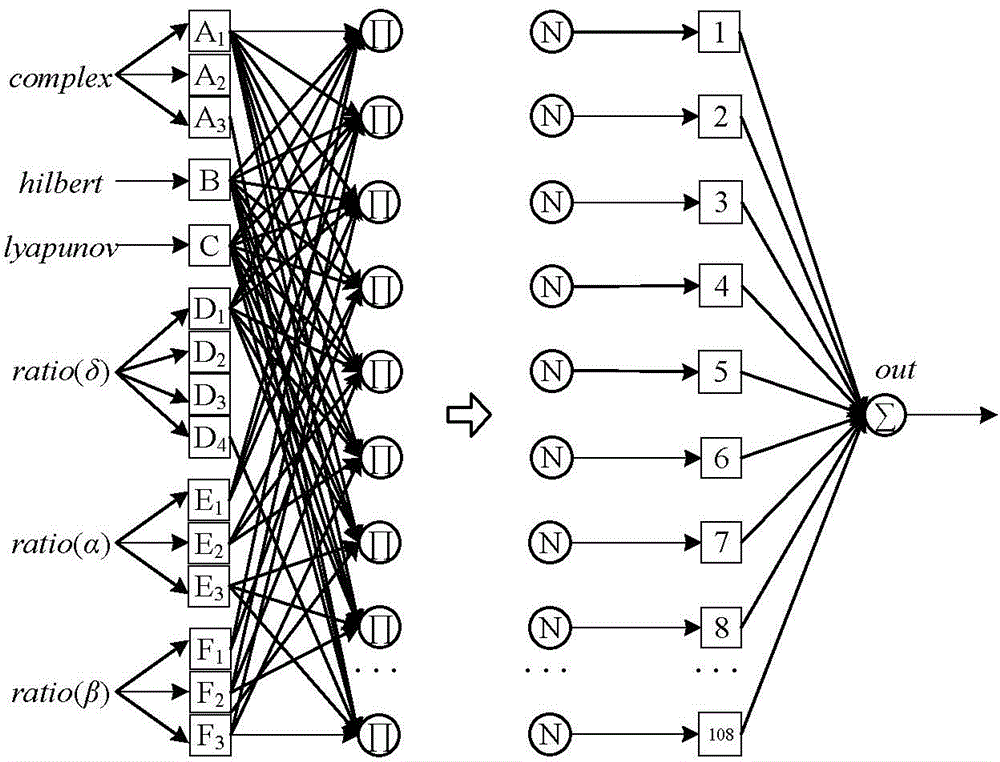Sleep staging method based on single-channel electroencephalogram signal ocular artifact removal
A technology of EEG signal and EEG artifacts, applied in instruments, character and pattern recognition, computer components, etc., can solve problems such as difficulties in knowledge extraction and expression, inability to learn knowledge, and inability to fully mine EEG signals. The effect of high accuracy, fast calculation speed, and improved accuracy of sleep staging
- Summary
- Abstract
- Description
- Claims
- Application Information
AI Technical Summary
Problems solved by technology
Method used
Image
Examples
specific Embodiment approach 1
[0061] Specific Embodiment 1: A sleep staging method based on single-channel EEG signal oculoelectric artifact removal in this embodiment is specifically prepared according to the following steps:
[0062] Step 1. Perform wavelet transformation on the collected single-channel EEG signal X(n) to obtain M wavelet coefficients; wherein, the M wavelet coefficients are divided into two categories: P wavelet coefficients that do not contain electrooculogram artifacts and The number of wavelet coefficients containing oculoelectric artifacts is M-P;
[0063] Step 2. For the P wavelet coefficients that do not contain electrooculogram artifacts, directly use them as pure EEG signals;
[0064] Step 3. After empirical mode decomposition, the M-P wavelet coefficients W(i) containing electrooculograph artifacts are expressed as the sum of the number of N intrinsic mode functions, that is, the number of IMF (Intrinsic Mode Function) components and the residual:
[0065] W ...
specific Embodiment approach 2
[0075] Specific embodiment 2: The difference between this embodiment and specific embodiment 1 is that the frequency domain parameters ratio(δ), ratio(θ), ratio(α) and ratio(β) extracted in step 7 are specifically:
[0076] According to the formula (2), (3), (4) and (5), the frequency band energy ratio of each frequency band signal in the pure EEG signal X(n) is calculated, that is, the characteristic parameters of the 4 frequency domain parameters are respectively:
[0077]ratio(δ)=E(δ) / E all (2)
[0078] Wherein, ratio (δ) is the frequency band energy ratio characteristic parameter of the δ frequency band in the pure EEG signal X(n);
[0079] ratio(θ)=E(θ) / E all (3)
[0080] Wherein, ratio (θ) is the frequency band energy ratio characteristic parameter of the θ frequency band in the pure EEG signal X (n);
[0081] ratio(α)=E(α) / E all (4)
[0082] Wherein, ratio (α) is the frequency band energy ratio characteristic parameter of the α frequency band in the pure EEG...
specific Embodiment approach 3
[0085] Specific embodiment three: the difference between this embodiment and specific embodiment one or two is: E(δ), E(θ), E(α) and E(β) are specifically:
[0086] Carry out frequency domain analysis on the pure EEG signal with oculoelectric artifacts removed, and extract the characteristic parameters of "frequency band energy ratio" of four rhythmic EEG signals;
[0087] (1), perform discrete Fourier transform on the pure EEG signal X(n) according to formula (6), and obtain the power spectrum P(k) of the signal X(n):
[0088] P ( k ) = Σ n = 0 N - 1 X ( n ) e - I 2 π N ...
PUM
 Login to View More
Login to View More Abstract
Description
Claims
Application Information
 Login to View More
Login to View More - Generate Ideas
- Intellectual Property
- Life Sciences
- Materials
- Tech Scout
- Unparalleled Data Quality
- Higher Quality Content
- 60% Fewer Hallucinations
Browse by: Latest US Patents, China's latest patents, Technical Efficacy Thesaurus, Application Domain, Technology Topic, Popular Technical Reports.
© 2025 PatSnap. All rights reserved.Legal|Privacy policy|Modern Slavery Act Transparency Statement|Sitemap|About US| Contact US: help@patsnap.com



